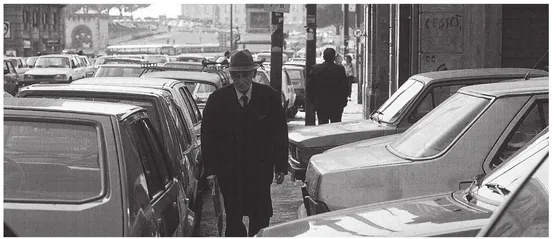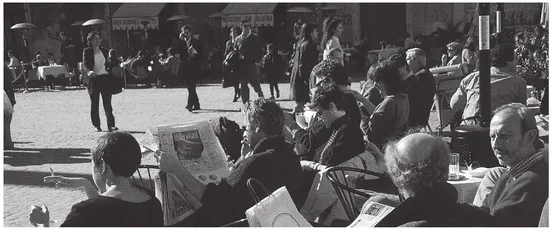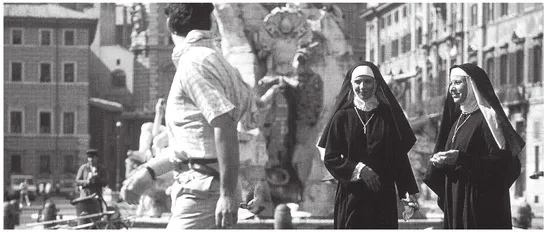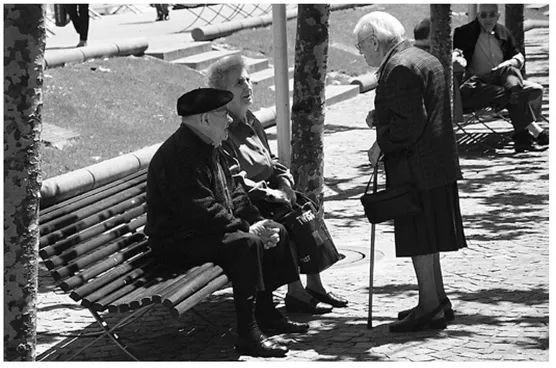
eBook - ePub
Life Between Buildings
Using Public Space
Jan Gehl
This is a test
Partager le livre
- English
- ePUB (adapté aux mobiles)
- Disponible sur iOS et Android
eBook - ePub
Life Between Buildings
Using Public Space
Jan Gehl
Détails du livre
Aperçu du livre
Table des matières
Citations
À propos de ce livre
"...thoughtful, beautiful, and enlightening..."
—Jane Jacobs"This book will have a lasting infl uence on the future quality of public open spaces. By helping us better understand the larger public life of cities, Life between Buildings can only move us toward more lively and healthy public places. Buy this book, fi nd a comfortable place to sit in a public park or plaza, begin reading, look around. You will be surprised at how you will start to see (and design) the world differently."
—Landscape Architecture
Foire aux questions
Comment puis-je résilier mon abonnement ?
Il vous suffit de vous rendre dans la section compte dans paramètres et de cliquer sur « Résilier l’abonnement ». C’est aussi simple que cela ! Une fois que vous aurez résilié votre abonnement, il restera actif pour le reste de la période pour laquelle vous avez payé. Découvrez-en plus ici.
Puis-je / comment puis-je télécharger des livres ?
Pour le moment, tous nos livres en format ePub adaptés aux mobiles peuvent être téléchargés via l’application. La plupart de nos PDF sont également disponibles en téléchargement et les autres seront téléchargeables très prochainement. Découvrez-en plus ici.
Quelle est la différence entre les formules tarifaires ?
Les deux abonnements vous donnent un accès complet à la bibliothèque et à toutes les fonctionnalités de Perlego. Les seules différences sont les tarifs ainsi que la période d’abonnement : avec l’abonnement annuel, vous économiserez environ 30 % par rapport à 12 mois d’abonnement mensuel.
Qu’est-ce que Perlego ?
Nous sommes un service d’abonnement à des ouvrages universitaires en ligne, où vous pouvez accéder à toute une bibliothèque pour un prix inférieur à celui d’un seul livre par mois. Avec plus d’un million de livres sur plus de 1 000 sujets, nous avons ce qu’il vous faut ! Découvrez-en plus ici.
Prenez-vous en charge la synthèse vocale ?
Recherchez le symbole Écouter sur votre prochain livre pour voir si vous pouvez l’écouter. L’outil Écouter lit le texte à haute voix pour vous, en surlignant le passage qui est en cours de lecture. Vous pouvez le mettre sur pause, l’accélérer ou le ralentir. Découvrez-en plus ici.
Est-ce que Life Between Buildings est un PDF/ePUB en ligne ?
Oui, vous pouvez accéder à Life Between Buildings par Jan Gehl en format PDF et/ou ePUB ainsi qu’à d’autres livres populaires dans Architecture et Architecture General. Nous disposons de plus d’un million d’ouvrages à découvrir dans notre catalogue.
Informations
Sujet
ArchitectureSous-sujet
Architecture General1. LIFE BETWEEN BUILDINGS
Three Types of Outdoor Activities
Life Between Buildings
Outdoor Activities and Quality of Outdoor Space
Outdoor Activities and Architectural Trends
Life Between Buildings – in Current Social Situations
Life Between Buildings
Outdoor Activities and Quality of Outdoor Space
Outdoor Activities and Architectural Trends
Life Between Buildings – in Current Social Situations
Three Types of Outdoor Activities
An ordinary day on an ordinary street. Pedestrians pass on the sidewalks, children play near front doors, people sit on benches and steps, the postman makes his rounds with the mail, two passersby greet on the sidewalk, two mechanics repair a car, groups engage in conversation. This mix of outdoor activities is influenced by a number of conditions. Physical environment is one of the factors: a factor that influences the activities to a varying degree and in many different ways. Outdoor activites, and a number of the physical conditions that influence them, are the subject of this book.
Greatly simplified, outdoor activities in public spaces can be divided into three categories, each of which places very different demands on the physical environment: necessary activities, optional activities, and social activities.
Necessary activities include those that are more or less compulsory – going to school or to work, shopping, waiting for a bus or a person, running errands, distributing mail – in other words, all activities in which those involved are to a greater or lesser degree required to participate.
In general, everyday tasks and pastimes belong to this group. Among other activities, this group includes the great majority of those related to walking.
Because the activities in this group are necessary, their incidence is influenced only slightly by the physical framework. These activities will take place throughout the year, under nearly all conditions, and are more or less independent of the exterior environment. The participants have no choice.
Optional activities – that is, those pursuits that are participated in if there is a wish to do so and if time and place make it possible – are quite another matter.
three types of outdoor activities

Necessary activities

Optional activities

Social activities
This category includes such activities as taking a walk to get a breath of fresh air, standing around enjoying life, or sitting and sunbathing.
These activities take place only when exterior conditions are favourable, when weather and place invite them. This relationship is particularly important in connection with physical planning because most of the recreational activities that are especially pleasant to pursue outdoors are found precisely in this category of activities. These activities are especially dependent on exterior physical conditions.
When outdoor areas are of poor quality, only strictly necessary activities occur.
When outdoor areas are of high quality, necessary activities take place with approximately the same frequency – though they clearly tend to take a longer time, because the physical conditions are better. In addition, however, a wide range of optional activities will also occur because place and situation now invite people to stop, sit, eat, play, and so on.
In streets and city spaces of poor quality, only the bare minimum of activity takes place. People hurry home.
In a good environment, a completely different, broad spectrum of human activities is possible.
Graphic representation of the relationship between the quality of outdoor spaces and the rate of occurrence of outdoor activities.
When the quality of outdoor areas is good, optional activities occur with increasing frequency. Furthermore, as levels of optional activity rise, the number of social activities usually increases substantially.

Social activities are all activities that depend on the presence of others in public spaces. Social activities include children at play, greetings and conversations, communal activities of various kinds, and finally — as the most widespread social activity – passive contacts, that is, simply seeing and hearing other people.
Different kinds of social activities occur in many places: in dwellings; in private outdoor spaces, gardens, and balconies; in public buildings; at places of work; and so on; but in this context only those activities that occur in publicly accessible spaces are examined.
These activities could also be termed “resultant” activities, because in nearly all instances they evolve from activities linked to the other two activity categories. They develop in connection with the other activities because people are in the same space, meet, pass by one another, or are merely within view.
Social activities occur spontaneously, as a direct consequence of people moving about and being in the same spaces. This implies that social activities are indirectly supported whenever necessary and optional activities are given better conditions in public spaces.
Greeting old friends, Bilbao

The more time people spend outdoors, the more frequently they meet and the more they talk. Chart plotting the relationship between the number of outdoor activities and frequency of interactions. (Street life sudies in Melbourne [20]. See also page 191.)

The character of social activities varies, depending on the context in which they occur. In the residential streets, near schools, near places of work, where there are a limited number of people with common interests or backgrounds, social activities in public spaces can be quite comprehensive: greetings, conversations, discussions, and play arising from common interests and because people “know” each other, if for no other reason than that they often see one another.
In city streets and city centers, social activities will generally be more superficial, with the majority being passive contacts — seeing and hearing a great number of unknown people. But even this modest type of activity can be very appealing.
Very freely interpreted, a social activity takes place every time two people are together in the same space. To see and hear each other, to meet, is in itself a form of contact, a social activity. The actual meeting, merely being present, is furthermore the seed for other, more comprehensive forms of social activity.
This connection is important in relation to physical planning. Although the physical framework does not have a direct influence on the quality, content, and intensity of social contacts, architects and planners can affect the possibilities for meeting, seeing, and hearing people – possibilities that both take on a quality of their own and become important as background and starting point for other forms of contact.
This is the background for the investigation in this book of meeting possibilities and opportunities to see and hear other people. Another reason for a comprehensive review of these activities is that precisely the presence of other people, activities, events, inspiration, and stimulation comprise one of the most important qualities of public spaces altogether.
If we look back at the street scene that was the starting point for defining the three categories of outdoor activities, we can see how necessary, optional, and social activities occur in a finely interwoven pattern. People walk, sit, and talk. Functional, recreational, and social activities intertwine in all conceivable combinations. Therefore, this examination of the subject of outdoor activities does not begin with a single, limited category of activities. Life between buildings is not merely pedestrian traffic or recreational or social activities. Life between buildings comprises the entire spectrum of activities, which combine to make communal spaces in cities and residential areas meaningful and attractive.
Both necessary, functional activities and optional, recreational activities have been examined quite thoroughly over the years in different contexts. Social activities and their interweaving to form a communal fabric have received considerably less attention.
This is the background for the following, more detailed examination of social activities in public spaces.

Contact at a modest level – but definitely contact.
Life Between Buildings
It is difficult to pinpoint precisely what life between buildings means in relation to the need for contact [14].
Opportunities for me...